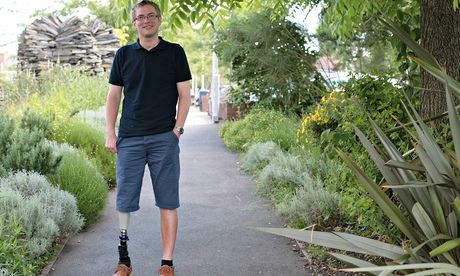
Revolutionary technology at a north London hospital has transformed the lives of amputees taking part in a trial by allowing artificial limbs to be attached directly to their skeleton, giving them feeling and mobility far beyond that experienced by people with traditional prosthetics.
Unlike traditional ball-and-socket joints where a socket is placed over the soft tissue of the stump, Itap (intraosseous transcutaneous amputation prosthesis) involves insertion of a metal implant that forms a direct interface with the bone and sticks out through the skin for the prosthetic to be attached.
If the trial conducted at the Royal National Orthopaedic hospital (RNOH) and the Royal Orthopaedic hospital in Birmingham, which ended in June, is deemed a success, Itap could be rolled out across the UK and internationally through specialist clinics.
Mark O'Leary, 40, from south London, was one of the first of 20 above-the-knee amputees to take part in the trial. He described the change it had made to his life. "Just knowing where my foot is, my ability to know where it is improved dramatically because you can feel it through the bone. A textured road crossing, I can feel that. You essentially had no sensation with a socket and with Itap you can feel everything," he said.
"It's like they've given me my leg back. I know that sounds a bit trite. With this thing I just click the stump on in the morning and I can walk as far as I like, do anything I want within reason. There's no limit."
The physicist, who works in the radiology department at St George's hospital in south London, said that pre-implant he was limited, like other amputees, in how much he could walk because of the discomfort caused by the socket rubbing against his soft tissue, a problem exacerbated by hot weather. As a result, he would often carry crutches or a stick as back-up.
Since having the implant in 2008, 15 years after losing part of his leg in a motorcycle crash, he has climbed Kilimanjaro and completed a 62 mile (100km) walk of the South Downs in just under 26 hours. "I had blisters on my good foot," he said. "In a way it was easier for me, I had one reliant foot [the prosthetic one]." O'Leary said he was "walking without limit" four months after having the Itap implanted.
The inspiration for Itap, developed by the UCL/RNOH biomedical engineering institute and manufactured by Stanmore Implants, came from research into how skin forms itself naturally around deer antlers. It found that the antler bone is porous under the skin and the inner layer of skin grows into the holes. The idea of Itap is for the skin and the tissue to merge into the metal implant, creating a seal that aims to prevent bacterial infections and enabling a prosthetic to be attached securely and carry weight in a natural way.
Among those who could benefit are the war wounded because short stumps, resulting for example from improvised explosive device blasts, tend to result in more problems with socket fitting and young, fit soldiers tend to have greater expectations of their prosthetics.
RNOH consultant William Aston said that while Itap would not be suitable for everyone, it could make a big difference to people with conventional prosthetics who often had skin conditions such as dermatitis and eczema, some of whom experienced such problems that they chose to go without an artificial limb. "Although a small group of patients can benefit there are significant benefits for those who do," said Aston.
With its quick-release mechanism, the Itap is also intended to make the prosthetic much easier to attach and remove – as demonstrated by O'Leary in a matter of seconds – than with a ball and socket. Additionally, like a ski binding, the mechanism releases to prevent damage to the bone or implant, such as during a fall.
The implant is inserted in a single operation, compared with other methods that require two operations.
Aston was unwilling to pre-empt the results of the trial evaluation, which will last between 12 and 18 months, but said: "All the patients that have come back to clinic report very significant improvements to their quality of life."
O'Leary said: "With a socketed leg my internal picture of myself was of a person with one leg. I got home, took it off, leant it against the side of the bed and I'd be so relieved [to take it off]. I'd hop round the flat. Fairly quickly into my rehab, my mental picture switched to that of a person with two legs. I very rarely take it off. It's difficult to describe just how good it is."

